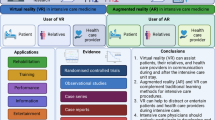Abstract
Emergency management of critically ill patients and a high expectation of mastery of technical medical skills are an essential aspect in a paramedics’ scope of practice. An entry level paramedic with limited exposure to high-risk critical patients is expected to perform interventions and utilize critical thinking skills at a mastery level when entering the workforce as reported by Zautchke et al. (The Journal of Emergency Medicine, 505–512, 1987). Paramedic programs in the USA continue to deliver the bulk of the course curriculum in a traditional classroom lecture format using 2-dimensional methods such as PowerPoint and lecture. Traditional, lecture-driven teaching methods rarely provide opportunities for paramedic students to directly witness the impact of their decisions and develop automaticity of their skills to reduce reaction times and prevent cognitive overload. Automacity is defined as making more automatic decisions and practices in the face of random incidences that occur in authentic conditions and is the result of repeated learning and practice. This definition is a classic example of a problematic circumstance which can utilize design thinking to resolve it. If the definition of design thinking is to use methods and processes for investigating ill-defined problems and finding solutions, then it is important for instructional designers to be innovative to assist them in recognizing these contexts, being creative in the generating appropriate solutions, and rationalizing/analyzing potential “best fit’ solutions. For years, EMT’s and paramedics have utilized mannequins (often called “Resuscitation Annies”) to teach recovery skills. Over the years, these mannequins have been augmented with technology to assist with skill development and to make them more interactive. Yet, as effective as they have been for the state of the art they represented, they have not been multifaceted enough for trainers to create an appropriate level of randomness that represent the ever complex situations paramedics and EMTs are becoming involved with. On top of that, the granularity and authenticity of the visual aspects caused these mannequins to suffer from a lack of a third dimensional realism, especially as it related, for example, to bodily fluids breakage and other sources of complications, for example.
Similar content being viewed by others
References
Albrecht, U., Folta-Schoofs, K., Behrends, M., & von Jan, U. (2013). Effects of mobile augmented reality learning compared to textbook learning on medical students: randomized controlled pilot study. Journal of Medical Internet Research, 15(8), e182. https://doi.org/10.2196/jmir.2497.
Barsom, E. Z., Graafland, M., & Schijven, M. P. (2016). Systematic review on the effectiveness of augmented reality applications in medical training. Surgical Endoscopy, 30(10), 4174–4183. https://doi.org/10.1007/s00464-016-4800-6.
Conradi, E., Kavia, S., Burden, D., Rice, A., Woodham, L., Beaumont, C., & Poulton, T. (2009). Virtual patients in a virtual world: training paramedic students for practice. Medical Teacher, 31(8), 713–720. https://doi.org/10.1080/01421590903134160.
Folguera, C. L. S., & Rodriguez-Lozano, F. (2017). Implementation of augmented reality inoperative dentistry learning. European Journal of Dental Education. https://doi.org/10.1111/eje.12269.
Küçük, S., Kapakin, S., & Göktaş, Y. (2016). Learning anatomy via mobile augmented reality: effects on achievement and cognitive load. American Association of Anatomists, 9, 411–421. https://doi.org/10.1002/ase.1603.
Mantovani, F., Castelnuovo, G., Gaggioli, A., & Riva, G. (2003). Virtual reality training for health-care professionals. Cyber Psychology & Behavior, 6(4), 389–395. https://doi.org/10.1089/109493103322278772.
Reis, E. (2011). The lean startup: how today’s entrepreneurs use continuous innovation to create radically successful businesses. New York: Crowne Business.
Sanson-Fisher, R. W. (2004). Diffusion of innovation theory for clinical change. The Medical Journal of Australia. https://doi.org/10.5694/j.1326-5377.2004.tb05947.x.
Zautchke, J. L., Lee, R. W., & Ethingon, N. A. (1987). Paramedic skill decay. The Journal of Emergency Medicine, 505–512.
Author information
Authors and Affiliations
Corresponding author
Ethics declarations
Ethical Considerations
There were no anticipated risks associated with this study. Participants were notified of the research question (hypothesis), scope, and process of the study. They were also told that participation in this study was purely voluntary, they could choose to discontinue participation at any time without harm or retribution. No compensation either monetarily or extra credit was awarded as evidenced by the informed consent document. For anonymity, students were given a number that was generated by a number randomizing program to use instead of their name. All the applicable guidelines set forth by the Institutional Review Board (IRB) were followed to protect the privacy of the participants and the objectivity of this study.
Additional information
Publisher’s Note
Springer Nature remains neutral with regard to jurisdictional claims in published maps and institutional affiliations.
Rights and permissions
About this article
Cite this article
Eggers, P., Ward, A. & Ensmann, S. Augmented Reality in Paramedic Training: a Formative Study. J Form Des Learn 4, 17–21 (2020). https://doi.org/10.1007/s41686-020-00041-7
Published:
Issue Date:
DOI: https://doi.org/10.1007/s41686-020-00041-7




